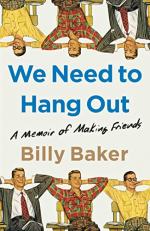|
This section contains 624 words (approx. 2 pages at 400 words per page) |

|
We Need to Hang Out Summary & Study Guide Description
We Need to Hang Out Summary & Study Guide includes comprehensive information and analysis to help you understand the book. This study guide contains the following sections:
This detailed literature summary also contains Topics for Discussion on We Need to Hang Out by Billy Baker.
The following version of this book was used to create this study guide: Baker, Billy. We Need to Hang Out: A Memoir of Making Friends. Avid Reader Press, an imprint of Simon and Schuster, Inc. New York, NY. 2021. First Avid Reader Press Hardcover Edition. The often-humorous, sometimes poignant story unfolds in first-person narration, as author Baker describes the before, during, and after of his discoveries around loneliness, friendship, and the challenges associated with establishing strong, vulnerable connections between (heterosexual) men. The use of parentheses around (heterosexual) throughout the analysis is a reflection of the narrative’s central perspective, one that goes unacknowledged by the author but which clearly defines his experiences, and the points he is making about those experiences.
Baker begins the story with a description of how he became drawn into it in the first place. A staff writer at the respected, prestigious Boston Globe newspaper, Baker is assigned to investigate what his editor suggests is an American epidemic of loneliness. The author reluctantly accepts the assignment, and then as he does his research, discovers that there is a second important aspect to the problem – what has been identified as a possible, powerful solution. That solution, he suggests throughout the book, is friendship.
As the narrative unfolds, Baker’s considerations of the power and value of friendship become more of a professional and personal priority. His explorations of loneliness and its dangers are still present for him, but as a result of realizing just how much he has neglected friendship in his own life, he becomes more and more focused on heading off the dangers of loneliness for and in himself. Meanwhile, the response to his initial article on loneliness gets a significant response from all over America and around the world, much of which references the ways that people, particularly (heterosexual) men, share his experiences of having lost track of the important, male-male connections in their lives.
Baker describes the various qualities and elements of his research, including his investigations of the friendships of women. He also conducts what might be described as his own, informal sorts of research – experimenting with different forms of reunions with high school friends, and traveling halfway around the world in an attempt at rebuilding long dormant relationships with other friends. He also experiments with a number of friendship-building activities to which he is introduced by acquaintances, by other friends, or by his research. Virtually all end in varying degrees of failure, but Baker progressively and consistently learns from his mistakes.
Baker eventually comes to realize that there is a particular set of circumstances and intentions that seems to be optimal for establishing and maintaining friendships between (heterosexual) men. He makes two attempts at following this pattern, the first with a group of long-term male friends which proves relatively successful. The second, as the author describes it, becomes the focus of much of the latter third of the book, and involves an elaborate set of plans and experiments. He has an initial degree of success with this attempt, but as he describes it, that success ultimately becomes quite limited – he makes new friends, but not in the numbers or in the way he originally intended. Still, he considers his experiment a success.
In the next-to-last chapter of the book, Baker considers his ideas and discoveries in terms of the coronavirus pandemic. He comments that among other things, the pandemic showed just how present the dangers of loneliness and the values of connections can become. Then, in the book’s final chapter, he offers an anecdotal illustration of how it is possible for (heterosexual) men to change their attitudes towards male-male connection, and to take positive, perhaps even life-saving, action in response to those changes
Read more from the Study Guide
|
This section contains 624 words (approx. 2 pages at 400 words per page) |

|



